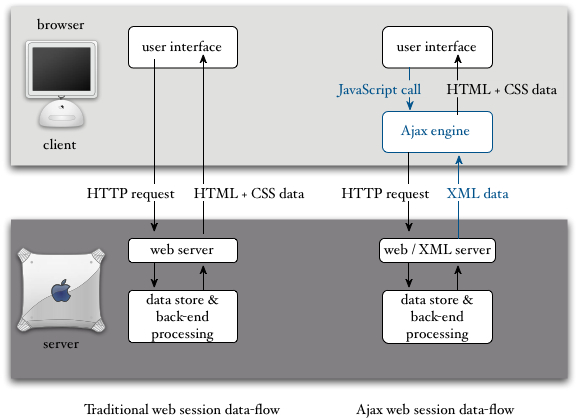FIT3084: AJAX : Asynchronous JavaScript and XML
In the previous lecture:
- Important points about the last lecture
In this lecture:
- What is Ajax?
- How is Ajax used?
References
Sebasta, R.W., "Programming the WWW 2009", 5th edition, Pearson, chapter 10.
http://www.url.net/
 |
About
- A collection of technolgies (that all pre-existed the name Ajax) used together to enhance user interaction on the WWW and support "Rich Internet Applications".
- The technologies for Ajax include:
JavaScript, Document Object Model (DOM), XML, Cascading Style Sheets (CSS), XMLHttpRequest object.
- The technology and methodology was used prior to 2005, but in 2005/2006 the idea was popularised through Google (in Google Maps and Gmail) and was named Ajax by Garrett.
- An acronym Asynchronous JavaScript and XML.
|
How does Ajax work?
Ajax is a way of using a collection of existing technologies to improve the rate at which a user can interact with a web page.
Ajax is not a langage or API. |
 |
A traditional exchange between client and web server is shown at left.
- The client sends a request for a document.
- The web server checks its file system / data-store for the requested info., possibly executes a script and returns an entire XHTML / CSS document.
- Whilst the server is responding, the client is blocked, waiting for the reply... and wasting the user's time as well as breaking interaction with a site into act-wait-act-wait steps as pages are received and re-rendered by the client.
|
An Ajax-styled session is also illustrated.
- The client sends an asynchronous request for a small amount of info. (typically only a small part of a web page that needs updating) to the server by activating JavaScript code.
- This request is sent via the Ajax engine to the server in the background whilst the user continues to interact with the web page.
- The server processes the request, synthesises its response (often but not always XML data) and sends it back to the Ajax engine.
- The Ajax engine converts the data into XHMTL / CSS and updates the part of the web-page that needs updating.
- The user can continue to interact with the web page during the whole process.
|
Example: Building a simple Ajax interaction
Phase 1. A WWW form
- Please enter a valid postal code into the space below.
NOTE: This version of the script will not work on Microsoft Internet Explorer browsers5 & 6 (see below).
- A PHP script will asynchronously update the text in the suburb box when you "blur" the box (e.g. hit the tab key).
About this form.
<form name="form1" method="" action="">
<p>
<label>Victorian postal code:
<input name="postcode" type="text" id="postcode" onBlur="getSuburb(this.value);" size="4" maxlength="4" />
</label>
<label> Victorian suburb:
<input name="suburb" type="text" id="suburb" size="50" readonly="readonly">
</label>
</p>
</form> |
- This form is an unsubmittable example without any method or action.
- The postcode text box registers an event handler: onBlur="getSuburb(this.value);"
- ...when the postcode blur event is generated, getSuburb() is called with parameter that is the value entered into the postcode text box, this.value.
- getSuburb() returns a result and the text box with id="suburb" will have its value set to this result without reloading the page.
Phase 2. JavaScript handler for the asynchronous event
- The following JavaScript resides in the <head> of this document. It is analysed in detail below.
<script language="JavaScript">
function getSuburb(code)
{
var xhr = new XMLHttpRequest();
xhr.onreadystatechange = function ()
{
if ((xhr.readyState == 4) && (xhr.status == 200))
{
var result = xhr.responseText;
document.getElementById("suburb").value = result;
}
}
var callString = "http://www.csse.monash.edu.au/~cema/cgi-bin/getSuburbFromCode.cgi?postcode=" + code;
xhr.open("GET", callString, true);
xhr.send(null);
}
</script> |
JavaScript analysis.
- The method getSuburb() must call a PHP script running on the server to convert its parameter to a string suburb name.
- The usual call to a CGI script would cause the browser to freeze whilst the result is being returned. But...
We make a new XMLHttpRequest object that is used to:
- call the CGI script asynchronously
- receive the updates on how the request is being handled
- receive the data when the request has been completed
xhr = new XMLHttpRequest();
|
Skipping down the code a little... we assemble the string that corresponds to the CGI script name.
We will call the CGI script using the GET method, so the string must include parameters after a "?".
var callString = "http://www.csse.monash.edu.au/~cema/cgi-bin/getSuburbFromCode.cgi?postcode=" + code; |
We use the XMLHttpRequest object's method:
- open() to organise a GET call to the CGI script of URL callString. The parameter true indicates we will call the script asynchronously.
- send() to initiate the request. The parameter allows us to send a string or DOM object to the server. (Not needed here so we send null).
xhr.open("GET", callString, true);
xhr.send(null); |
Backtracking through the code a little...
The XMLHttpRequest object triggers a readystatechange event if its readyState property's value is changed.
The XMLHttpRequest object has a property onreadystatechange that must point to a method to handle the these changes.
Here we set the event handler to be an internal function() without a name.
xhr.onreadystatechange = function ()
{
...
} |
The function() will be called multiple times as the server handles the request and updates the object's readyState property.
| XMLHttpRequest.readyState values |
| 0 |
XMLHttpRequest has been created but not yet uninitialised |
| 1 |
XMLHttpRequest.open() has been called and object is ready to send |
| 2 |
XMLHttpRequest.send() has been called but no response received |
| 3 |
XMLHttpRequest has received the HTTP response headers but not the complete message body |
| 4 |
XMLHttpRequest has received all header and body information |
The value that tells us that the request has been completed is readyState==4.
The XMLHttpRequest object's status property is set by the server to the HTTP status code.
E.g. 200 (OK) or 404 (Not Found). The value of this property is undefined if readyState<3.
if ((xhr.readyState == 4) && (xhr.status == 200))
{
...
} |
If the request was completed successfully, the XMLHttpRequest object holds the response text.
In our example, we insert this into the value attribute of the suburb text entry box.
var result = xhr.responseText;
document.getElementById("suburb").value = result;
|
3. PHP script.
In: post code parameter
Out: corresponding suburb's name
#!/usr/local/bin/php
<?php
$suburbArray = array(
"3000" => "Melbourne Melbourne",
"3001" => "Melbourne Melbourne",
"3002" => "Melbourne East Melbourne",
"3003" => "Melbourne West Melbourne",
"3005" => "Melbourne World Trade Centre",
"3006" => "Melbourne Southbank",
...[many post codes omitted for clarity]...
);
header("Content-type: text/plain;");
$postcode = $_GET["postcode"];
if (array_key_exists($postcode, $suburbArray))
{
print $suburbArray[$postcode];
}
else
{
print "unrecognised postcode";
}
?> |
|
Note that the Content-type returned by this script is text/plain. This is not always the case (see below).
Otherwise this PHP program is a normal CGI scrip that can be executed as normal:
http://www.csse.monash.edu.au/~cema/cgi-bin/getSuburbFromCode.cgi?postcode=3000
Working with Microsoft Internet Explorer 5 & 6.
Microsoft's Internet Explorer 5 & 6 web browsers do not employ the XMLHttpRequest object.
Instead, they employ an ActiveXObject called XMLHTTP.
For compatability with all browsers therefore, replace the object creation code above with:
if (window.XMLHttpRequest)
{ xhr = new XMLHttpRequest(); }
else
{ xhr = newActiveXObject("Microsoft.XMLHTTP"); }
|
Apart from this, all browsers will operate in the same way.
Return Document Types
1. Plain text return document type.
- Discussed in the example above.
- Commonly used where the returned data is simple.
2. XHTML return document type.
Suppose we have a <div> tag in the current document like this:
<div id="replaceableXHTML">
<p>
Some text, a <a href="http://www.nerd.com">link</a>, any XHMTL can go in here.
</p>
</div> |
If a script generates some XHMTL that is returned via XMLHttpRequest.responseText:
<p>Some different text.</p>
<ul>
<li>a list element</li>
<li>another list element</li>
</ul>
<p>Some other XHMTL can go in here.</p>
|
The initial text in the <div> tag can be substitued for the returned text:
document.getElementById("replaceableXHTML").innerHTML = xhr.responseText; |
Here is the method in action (see method replaceText() in the <head> of this document)...
3. XML return document type.
We don't cover XML during this unit but you still need to understand a few things since the X in Ajax refers to XML...
Writing parsers for XML (to create XHTML) is a little complex and error prone.
If the structure of the existing document matches the structure of the returned XML, after the XML is parsed, the existing document's components can be swapped using the innerHTML property as in the example above.
Otherwise, DOM methods such as createElement() and appendChild() can be used to generate new XHTML document objects once the XML has been parsed.
<html>
<head>
<title>Creating elements</title>
</head>
<script type="text/javascript">
var theOriginalDiv = null;
var newDiv = null;
var p = null;
function addElements()
{
// create a new div element and give it some content
newDiv = document.createElement("div");
newDiv.innerHTML = "<h1>This is a heading!</h1>";
// add the newly created element and it's content into the DOM
theOriginalDiv = document.getElementById("originalDiv");
document.body.insertBefore(newDiv, theOriginalDiv);
// Create a new paragraph element, and append it to the end of the document body
p = document.createElement("p");
p.innerHTML = "This is an <em>appended</em> paragraph";
document.body.appendChild(p);
}
</script>
<body onload="addElements()">
<div id='originalDiv'> The heading above was generated dynamically.</div>
</body>
</html> |
View this example in a web browser.
Advanced Ajax examples.
Google Maps
http://www.ajax.org/#home
This lecture's key point(s):
- Ajax is a collection of web technologies (CSS, DOM, JavaScript, XML) used to asynchronously request and receive data from a web server.
- Ajax smooths the interaction between a user and web page by updating only the parts of a web page that need changing.
- Ajax requires the use of an XMLHttpRequest object to send parameters from a client to a server, monitor the request and receive the reply.
Courseware | Lecture notes
©Copyright
Alan Dorin 2009

